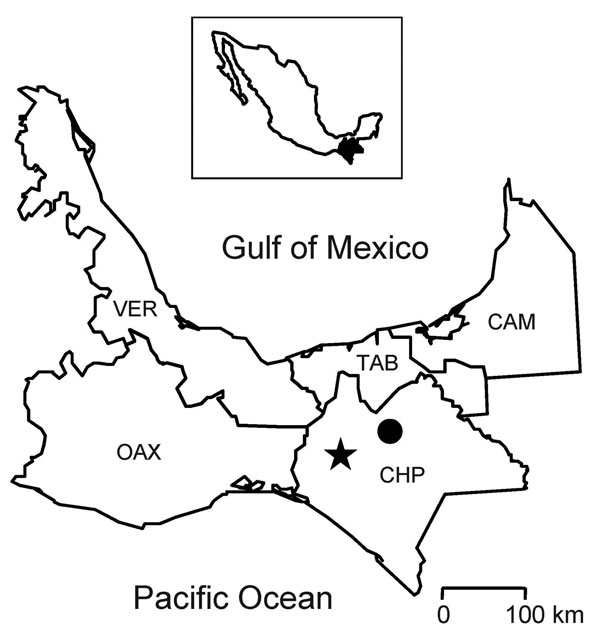Volume 18, Number 3—March 2012
Research
Ocozocoautla de Espinosa Virus and Hemorrhagic Fever, Mexico
Figure 1

Figure 1. Chiapas (CHP) and surrounding states in southern Mexico. The star indicates where the rodents in this study were captured; the solid circle indicates the location of the hospital that provided care for the persons affected by hemorrhagic fever in the 1967 epidemic (17). Inset shows the location of CHP in Mexico. CAM, Campeche; OAX, Oaxaca; TAB, Tabasco; VER, Veracruz.
References
- Salvato MS, Clegg JC, Buchmeier MJ, Charrel RN, Gonzalez J-P, Lukashevich IS, Family Arenaviridae. In: Fauquet CM, Mayo MA, Maniloff J, Desselberger U, Ball LA, editors: Virus taxonomy: eighth report of the International Committee on Taxonomy of Viruses. New York: Elsevier Academic Press; 2005. p. 725–33.
- Milazzo ML, Cajimat MNB, Haynie ML, Abbott KD, Bradley RD, Fulhorst CF. Diversity among Tacaribe serocomplex viruses (family Arenaviridae) naturally associated with the white-throated woodrat (Neotoma albigula) in the southwestern United States. Vector Borne Zoonotic Dis. 2008;8:523–40. DOIPubMedGoogle Scholar
- Cajimat MN, Milazzo ML, Bradley RD, Fulhorst CF. Catarina virus, an arenaviral species principally associated with Neotoma micropus (southern plains woodrat) in Texas. Am J Trop Med Hyg. 2007;77:732–6.PubMedGoogle Scholar
- Cajimat MN, Milazzo ML, Borchert JN, Abbott KD, Bradley RD, Fulhorst CF. Diversity among Tacaribe serocomplex viruses (family Arenaviridae) naturally associated with the Mexican woodrat (Neotoma mexicana). Virus Res. 2008;133:211–7. DOIPubMedGoogle Scholar
- Inizan CC, Cajimat MN, Milazzo ML, Barragán-Gomez A, Bradley RD, Fulhorst CF. Genetic evidence for a Tacaribe serocomplex virus, Mexico. Emerg Infect Dis. 2010;16:1007–10.PubMedGoogle Scholar
- Delgado S, Erickson BR, Agudo R, Blair PJ, Vallejo E, Albariño CG, Chapare virus, a newly discovered arenavirus isolated from a fatal hemorrhagic fever case in Bolivia. PLoS Pathog. 2008;4:e1000047. DOIPubMedGoogle Scholar
- Peters CJ. Human infection with arenaviruses in the Americas. Curr Top Microbiol Immunol. 2002;262:65–74. DOIPubMedGoogle Scholar
- Musser GG, Carleton MD. Family Cricetidae. In: Wilson DE, Reeder DM, editors. Mammal species of the world: a taxonomic and geographic reference. 3rd ed. Baltimore; The Johns Hopkins University Press; 2005. p. 955–1189.
- Fulhorst CF, Bowen MD, Salas RA, Duno G, Utrera A, Ksiazek TG, Natural rodent host associations of Guanarito and Pirital viruses (family Arenaviridae) in central Venezuela. Am J Trop Med Hyg. 1999;61:325–30.PubMedGoogle Scholar
- Milazzo ML, Cajimat MN, Duno G, Duno F, Utrera A, Fulhorst CF. Transmission of Guanarito and Pirital viruses among wild rodents, Venezuela. Emerg Infect Dis. 2011;17:2209–15. DOIPubMedGoogle Scholar
- Mills JN, Ellis BA, McKee KT Jr, Calderon GE, Maiztegui JI, Nelson GO, A longitudinal study of Junin virus activity in the rodent reservoir of Argentine hemorrhagic fever. Am J Trop Med Hyg. 1992;47:749–63.PubMedGoogle Scholar
- Acuna-Soto R, Romero LC, Maguire JH. Large epidemics of hemorrhagic fevers in Mexico 1545–1815. Am J Trop Med Hyg. 2000;62:733–9.PubMedGoogle Scholar
- Marr JS, Kiracofe JB. Was the huey cocoliztli a haemorrhagic fever? Med Hist. 2000;44:341–62.PubMedGoogle Scholar
- Milazzo ML, Barragán-Gomez A, Hanson JD, Estrada-Franco JG, Arellano E, González-Cózatl FX, Antibodies to Tacaribe serocomplex viruses (family Arenaviridae, genus Arenavirus) in cricetid rodents from New Mexico, Texas, and Mexico. Vector Borne Zoonotic Dis. 2010;10:629–37. DOIPubMedGoogle Scholar
- Bradley RD, Durish ND, Rogers DS, Miller JR, Engstrom MD, Kilpatrick CW. Toward a molecular phylogeny for Peromyscus: evidence from mitochondrial cytochrome-b sequences. J Mammal. 2007;88:1146–59. DOIPubMedGoogle Scholar
- Tesh RB, Wilson ML, Salas R, de Manzione NM, Tovar D, Ksiazek TG, Field studies on the epidemiology of Venezuelan hemorrhagic fever: implication of the cotton rat Sigmodon alstoni as the probable rodent reservoir. Am J Trop Med Hyg. 1993;49:227–35.PubMedGoogle Scholar
- Goldsmith RS, Shields KP. Epidemic in southern Mexico of disease resembling virus haemorrhagic fevers. Lancet. 1971;298:151–4. DOIPubMedGoogle Scholar
- Cajimat MN, Milazzo ML, Hess BD, Rood MP, Fulhorst CF. Principal host relationships and evolutionary history of the North American arenaviruses. Virology. 2007;367:235–43. DOIPubMedGoogle Scholar
- Bowen MD, Peter CJ, Nichol ST. The phylogeny of New World (Tacaribe complex) arenaviruses. Virology. 1996;219:285–90. DOIPubMedGoogle Scholar
- Erixon P, Svennblad B, Britton T, Oxelman B. Reliability of Bayesian posterior probabilities and bootstrap frequencies in phylogenetics. Syst Biol. 2003;52:665–73. DOIPubMedGoogle Scholar
- Thompson JD, Higgins DG, Gibson TJ. CLUSTAL W (1.7): improving the sensitivity of progressive multiple sequence alignment through sequence weighting, position-specific gap penalties and weight matrix choices. Nucleic Acids Res. 1994;22:4673–80. DOIPubMedGoogle Scholar
- Huelsenbeck JP, Ronquist FR. MRBAYES: Bayesian inference of phylogenetic trees. Bioinformatics. 2001;17:754–5. DOIPubMedGoogle Scholar
- Swofford DL. PAUP*: phylogenetic analysis using parsimony (*and other methods), version 4.0b10. Sunderland (MA): Sinauer Associates; 2002.
- Bowen MD, Peters CJ, Nichol ST. Phylogenetic analysis of the Arenaviridae: patterns of virus evolution and evidence for cospeciation between arenaviruses and their rodent hosts. Mol Phylogenet Evol. 1997;8:301–16. DOIPubMedGoogle Scholar
- Tesh RB, Jahrling PB, Salas R, Shope RE. Description of Guanarito virus (Arenaviridae: Arenavirus), the etiologic agent of Venezuelan hemorrhagic fever. Am J Trop Med Hyg. 1994;50:452–9.PubMedGoogle Scholar
- Trujano-Alvarez AL, Alvarez-Castañeda ST. Peromysus mexicanus (Rodentia: Cricetidae). Mammalian Species. 2010;42:111–8. DOIGoogle Scholar
- Montali RJ, Scanga CA, Pernikoff D, Wessner DR, Ward R, Holmes KV. A common-source outbreak of callitrichid hepatitis in captive tamarins and marmosets. J Infect Dis. 1993;167:946–50. DOIPubMedGoogle Scholar
- Barragán F, Retana OG, Naranjo EJ. The rodent trade of Tzeltal Indians of Oxchuc, Chiapas, Mexico. Hum Ecol. 2007;35:769–73. DOIGoogle Scholar
Page created: February 16, 2012
Page updated: February 16, 2012
Page reviewed: February 16, 2012
The conclusions, findings, and opinions expressed by authors contributing to this journal do not necessarily reflect the official position of the U.S. Department of Health and Human Services, the Public Health Service, the Centers for Disease Control and Prevention, or the authors' affiliated institutions. Use of trade names is for identification only and does not imply endorsement by any of the groups named above.